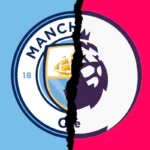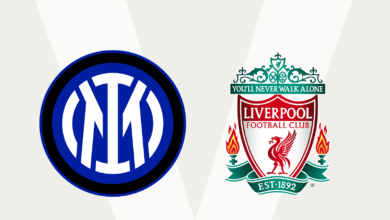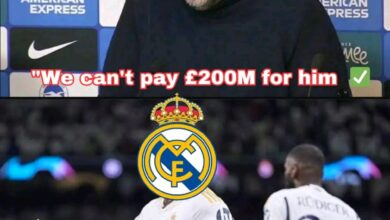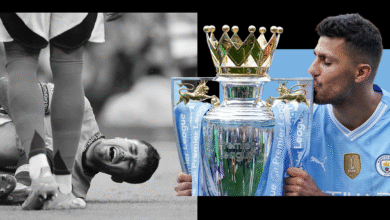Dark days’ – John Stones opens up on Man City injury hell ahead of Club World Cup comeback
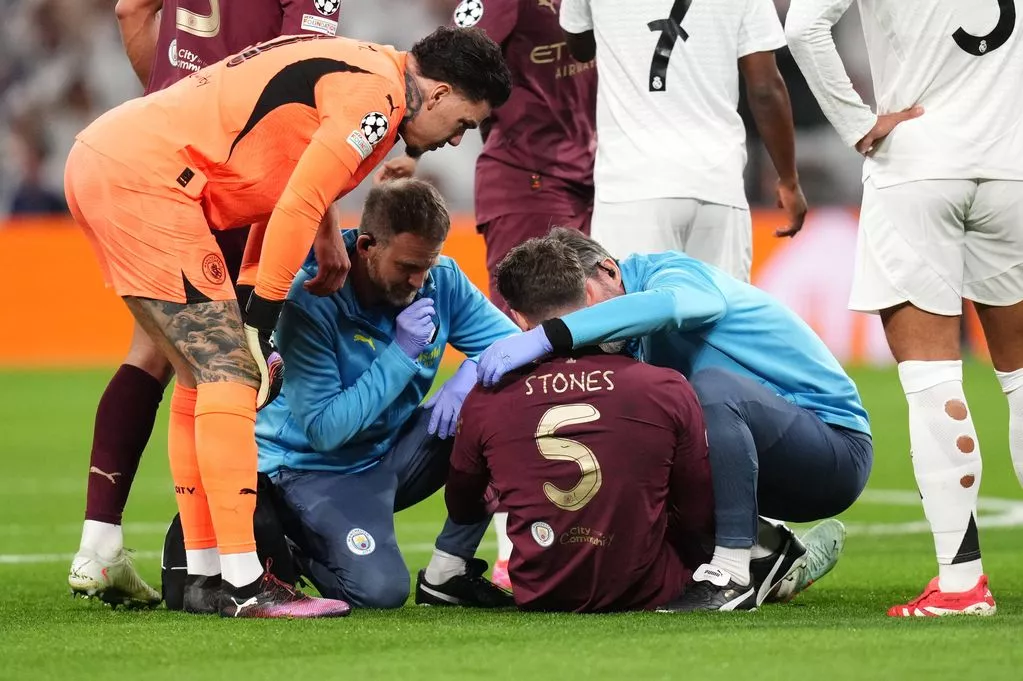
Before we talk about his recent struggles, it’s important to understand who John Stones is and why his story matters so much to football fans.
John Stones started his professional career at a young age. He worked his way up through different football clubs, always dreaming of playing at the highest level. His hard work paid off when he joined Manchester City, one of the best football teams in England and the world.
Stones is what football people call a “center-back” or “central defender.” This means his main job is to stop the other team from scoring goals. He stands near his team’s goal and tries to block shots, win the ball back from opponents, and help his team start new attacks.
What makes Stones special is that he’s not just good at defending – he’s also very good with the ball at his feet. Many defenders just kick the ball away when they get it, but Stones can pass the ball accurately to his teammates and even help his team attack. This skill made him very valuable to both Manchester City and England.
The Golden Years
To understand how hard his recent struggles have been, we need to look at what John Stones achieved before his injury problems began.
In the 2022-23 football season, Stones had one of the best years of his career. This was the season when Manchester City achieved something very special in football – they won what’s called “the treble.” This means they won three major competitions in the same year: the Premier League (the top English league), the FA Cup (England’s oldest football competition), and the Champions League (the best competition for European clubs).
Winning the treble is extremely rare. Very few teams in history have ever done it. For Stones, being a key player in this historic achievement was the highlight of his career. He played in most of the important games and was one of the reasons why Manchester City was so successful that year.
During this golden period, Stones felt on top of the world. He was playing regularly, his team was winning everything, and he was considered one of the best defenders in English football. Everything seemed perfect, and the future looked bright.
When Everything Changed
But football, like life, can change very quickly. What happened to John Stones over the next two years shows how cruel sports can be, even to the most successful players.
The problems started at the beginning of the 2023-24 season. Just when Stones should have been celebrating his treble success and looking forward to more victories, he got injured. This wasn’t just a small injury that would keep him out for a few days – it was a serious hip problem that required a long time to heal.
For two whole months, Stones couldn’t play football. He had to watch from the sidelines as his teammates played in important games. For any professional athlete, being unable to do what they love most is incredibly difficult. But for Stones, this was just the beginning of his troubles.
When he finally recovered from his hip injury and returned to playing, he thought his problems were over. Unfortunately, this wasn’t the case. What followed was what doctors and sports experts call a “cascade of injuries” – when one injury leads to another, and then another.
The Injury Nightmare Continues
The 2024-25 season was supposed to be John Stones’ comeback year. After recovering from his hip injury, he was ready to prove that he was still one of the best defenders in the world. But his body had different plans.
Throughout the season, Stones kept getting hurt. First, it was his thigh – the large muscle in the upper part of his leg that football players use for running and kicking. Thigh injuries are particularly frustrating for football players because they affect almost everything you do on the field.
Then came foot problems. The feet are incredibly important for football players – they use them to run, pass, shoot, and control the ball. When a player has foot problems, it affects their entire game. They can’t run as fast, their passing becomes less accurate, and they lose confidence in their ability to play.
The most heartbreaking moment came in February 2025, during a game against Real Madrid, one of the biggest teams in world football. Stones started the game, hoping to show that he was back to his best. But after just eight minutes on the field, he felt pain and had to be substituted. He walked off the field knowing that he would be out for months again.
In total, during the 2024-25 season, John Stones only started six games in the Premier League. For a player who was used to playing in almost every important game, this was devastating.
The Mental Battle
While the physical pain of injuries is obvious, what many people don’t understand is the mental and emotional pain that comes with being unable to play.
John Stones was very honest about how difficult this period was for him mentally. He talked about having “dark days” – times when he felt hopeless and wondered if he would ever be the same player again.
“Yes, there have been times when I thought about giving up,” Stones admitted. “I work so hard and give everything to football, both when playing and training. But I kept getting hurt – those were the dark days.”
For someone who had dedicated his entire life to football, these thoughts were terrifying. Stones explained that he puts enormous pressure on himself to perform and to be available for his team. When injury after injury kept him on the sidelines, he began to doubt everything about himself.
“It makes me angry and frustrated. I put a lot of pressure on myself. It’s very hard mentally,” he said. “I’ve had some really low points this past season. When you keep getting hurt over and over, you can’t see when it will end.”
This is something that many professional athletes experience but few talk about openly. The pressure to perform, combined with the frustration of being unable to do what you love, can lead to depression, anxiety, and thoughts of giving up entirely.
Stones described the feeling of not being able to see “the end of the tunnel.” This is a powerful way of explaining how hopeless he felt. Every time he thought he was getting better, another injury would happen, and he would be back to square one.
The Questions Everyone Asks
During his darkest moments, Stones found himself asking the same questions that anyone going through a difficult time might ask: “Why is this happening to me? What did I do wrong? Will things ever get better?”
These are natural human reactions to suffering. When bad things happen repeatedly, it’s normal to look for reasons or someone to blame. But sometimes, there are no easy answers. Sometimes, bad things just happen, and the only choice is how to respond.
Stones talked about how everyone goes through difficult times in their lives, whether they’re football players or not. The difference is in how people choose to respond to these challenges.
“We all grow up differently and face different challenges,” he explained. “When hard times come, do we fight or do we give up?”
This question gets to the heart of what makes some people able to overcome adversity while others are defeated by it. For Stones, the answer came from looking back at his childhood and remembering the lessons he learned about perseverance.
Learning to Fight
John Stones didn’t become a professional football player by accident. Like all successful athletes, he had to overcome many obstacles and challenges throughout his life. These early experiences taught him valuable lessons that would help him during his injury crisis.
“I was always a fighter, even as a kid,” Stones said. “In tough moments, you have to look at the big picture. You have to remember what you believe in and keep fighting to make it worth it.”
This fighting spirit is what separates professional athletes from regular people. While most of us might give up when faced with repeated setbacks, elite athletes have learned to keep pushing forward even when everything seems hopeless.
For Stones, this meant continuing to train and work on his fitness even when he couldn’t play games. It meant going to physical therapy sessions, following strict medical advice, and maintaining hope that he would eventually return to full health.
The Support System
No one overcomes major challenges alone, and John Stones was fortunate to have a strong support system around him during his difficult period.
Manchester City, as a football club, invested heavily in helping Stones recover. They provided him with the best medical care available, including doctors, physiotherapists, nutritionists, and mental health specialists. The club knew that Stones was a valuable player and was willing to be patient while he worked through his injury problems.
His teammates also played an important role in keeping his spirits up. Professional football is a team sport, and good teammates support each other through both good times and bad times. Even when Stones couldn’t play, his fellow players made sure he felt like an important part of the team.
His family and friends outside of football were equally important. Having people who love and support you regardless of your professional success can make the difference between giving up and finding the strength to continue.
The Medical Challenge
From a medical perspective, John Stones’ situation was complex. When athletes have multiple injuries in a short period of time, it’s often because their body is trying to compensate for one problem by putting extra stress on other parts.
For example, when someone has a hip injury, they might change the way they run or walk to avoid pain. This changed movement pattern can then put extra stress on the thigh muscles or feet, leading to new injuries. This is why treating injured athletes requires not just fixing the immediate problem, but also addressing the underlying issues that might cause future problems.
Sports medicine doctors had to work carefully with Stones to not only heal his current injuries but also strengthen his entire body to prevent future problems. This process takes time and patience, something that can be very difficult for athletes who are used to seeing quick results from their training.
The Comeback Plan
As Stones began to recover from his latest injuries, he and his medical team developed a careful plan for his return to football. This wasn’t just about getting him healthy enough to play – it was about making sure he could stay healthy once he returned.
The plan included specific exercises to strengthen the muscles that had been injured, as well as work on his overall fitness and movement patterns. Mental health support was also included, helping Stones deal with the fear and anxiety that often comes with returning from serious injuries.
One of the biggest challenges for any athlete coming back from a long injury is the fear of getting hurt again. This fear can actually make new injuries more likely, as athletes might play too cautiously or tense up their muscles in ways that increase injury risk.
Looking Forward: The Club World Cup
As John Stones worked toward his comeback, he had a specific goal in mind: the Club World Cup. This tournament, featuring the best club teams from around the world, was being held in the United States and represented a chance for Manchester City to win another prestigious trophy.
For Stones, the Club World Cup represented more than just another competition – it was a symbol of his return to top-level football. After months of watching from the sidelines, he was determined to play a significant role in helping his team succeed.
The tournament also represented a fresh start. While his injury problems had been well-documented in the English media, the Club World Cup would give him a chance to show the world that he was back to his best.
Lessons for Everyone
While John Stones’ story is about professional football, the lessons from his experience apply to anyone facing difficult challenges in their life.
First, it’s normal to have dark moments when everything seems hopeless. Even the most successful people go through periods of doubt and despair. What matters is not avoiding these feelings, but learning how to work through them.
Second, having a fighting spirit is crucial for overcoming adversity. This doesn’t mean being aggressive or angry – it means having the determination to keep trying even when things seem impossible.
Third, no one succeeds alone. Having a strong support system of family, friends, and professional colleagues can make the difference between giving up and finding the strength to continue.
Finally, setbacks and failures are not permanent unless we allow them to be. Even the most serious injuries can heal, and even the darkest periods can give way to brighter days.
The Bigger Picture
John Stones’ injury struggles highlight some important issues in modern professional football. The sport has become faster and more physical than ever before, leading to more injuries. Players are expected to play more games than in the past, giving their bodies less time to recover between matches.
Many football clubs and organizations are now paying more attention to player welfare, recognizing that keeping athletes healthy is better for everyone than pushing them to play when they’re not ready.
Conclusion: From Darkness to Light
John Stones’ story is still being written. While he has faced incredible challenges over the past two years, his determination to overcome them shows the kind of character that made him a successful professional footballer in the first place.
His willingness to talk openly about his struggles, including his mental health challenges, is also important. By sharing his story, Stones helps other people – both athletes and non-athletes – understand that it’s okay to have dark moments and that asking for help is a sign of strength, not weakness.
As he prepares for his return to football, Stones carries with him the lessons learned during his most difficult period. These experiences have made him stronger, more resilient, and more appreciative of the opportunity to play the sport he loves.
For Manchester City fans, England supporters, and football lovers around the world, John Stones’ comeback story serves as a reminder that the human spirit is incredibly powerful. Even in the darkest times, there is always hope for a better tomorrow.
His journey from the heights of winning the treble, through the depths of repeated injuries and self-doubt, and back toward the light of recovery and return, shows us that life’s greatest victories often come not from avoiding challenges, but from finding the courage to face them head-on.
The “dark days” that John Stones described are now behind him. Ahead lies the promise of new challenges, new victories, and the satisfaction that comes from refusing to give up when things seemed impossible. In the end, that might be his greatest achievement of all.



